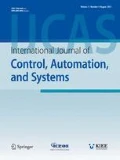Abstract
The control of the HIV infection is considered in the framework of the optimal control theory within the problem of resource allocation. A control action, changing the intervention strategy on the basis of the updated situations, is proposed. The switching instants are not fixed in advance but are determined along with the final control time. A constructive algorithm to compute iteratively the switching control is outlined. The solutions obtained provide interesting and promising results.
Similar content being viewed by others
References
P. Di Giamberardino, L. Compagnucci, C. De Giorgi, and D. Iacoviello, “A new model of the HIV/AIDS infection diffusion and analysis of the intervention effects,” Proc. of 25th IEEE Mediterranean Conference on Control and Automation, pp. 291–296, 2017.
C. Xiong, Y. Zhou, C. Yu, and H. Mei, “Control model of the HIV/AIDS epidemic based on kinetic equation, ” World Journal of AIDS, vol. 3, pp. 79–84, 2013. [click]
D. Wodarz, “Helper-dependent vs. helper-independent CTL responses in HIV infection: implications for drug therapy and resistance,” Journal Theor. Biol., vol. 213, pp. 447–459, 2001. [click]
H. Chang and A. Astolfi, “Control of HIV infection dynamics,” IEEE Control Systems, vol. 28, no. 2, pp. 28–39, 2009.
H. T. Banks, H. D. Kwon, J. A. Toivanen, and H. T. Tran, “A state-dependent Riccati equation-based estimator approach for HIV feedback control,” Opt. Control Applications and Methods, vol. 27, pp. 93–121, 2006.
H. R. Joshi, “Optimal control of an HIV immunology model,” Opt. Control Applications and Methods, vol. 23, 199–213, 2002.
Y. Zhou, K. Yang, K. Zhou, and C. Wang, “Optimal treatment strategies for HIV with antibody response,” Journal of Applied Mathematics, vol. 52, pp. 1–13, 2014
E. A. H. Vargas, P. Colaneri, and R. H. Middleton, “Switching strategies to mitigate HIV mutation,” IEEE Trans. on Control System Technology, vol. 22, no. 4, pp. 1623–1628, 2014. [click]
S. K. Kim, D. Kim, and T.W. Yoon, “Adaptive observer for estimating the parameters of an HIV model with mutants,” International Journal of Control, Automation and Systems, vol. 13, no. 1, pp. 126–137, 2015. [click]
Y. Ding, Z. Wang, and H. Ye, “Optimal control of a fractional-order HIV-immune system with memory,” IEEE Trans. on Control System Technology, vol. 30, no. 3, pp. 763–769, 2012.
E. C. Yuan, D. L. Alderson, S. Stromberg, and J. M. Carlson, “Optimal vaccination in a stochastic epidemic model of two non-interacting populations,” PLOS ONE, pp. 1–25, 2015.
H. Shim, S. J. Han, C. C. Chung, S.W. Nam, and J. H. Seo, “Optimal scheduling of drug treatment for HIV infection: continuous dose control and receding horizon control,” International Journal of Control, Automation, and Systems, vol. 1, no. 3, pp. 282–288, 2003.
R. F. Hartl, S. P. Sethi, and R. G. Vickson, “A survey of the maximum principles for optimal control problems with state constraints,” Society for Industrial and Applied Mathematics, vol. 37, pp. 181–218, 1995. [click]
C. Li, X. Yu, Z. Liu, and T. Huang, “Asynchronous impulsive containment controlling switched multi-agent systems,” Information Sciences, vol. 370, pp. 667–679, 2016.
X. Ding and X. Liu, “Stability analysis for switched positive linear systems under state dependent switching,” International Journal of Control, Automations and Systems, vol.15, pp. 481–488, 2017. [click]
Author information
Authors and Affiliations
Corresponding author
Additional information
Recommended by Associate Editor M. Chadli under the direction of Editor Myo Taeg Lim.
Rights and permissions
About this article
Cite this article
Di Giamberardino, P., Iacoviello, D. HIV Infection Control: A Constructive Algorithm for a State-based Switching Control. Int. J. Control Autom. Syst. 16, 1469–1473 (2018). https://doi.org/10.1007/s12555-017-0211-2
Received:
Revised:
Accepted:
Published:
Issue Date:
DOI: https://doi.org/10.1007/s12555-017-0211-2




